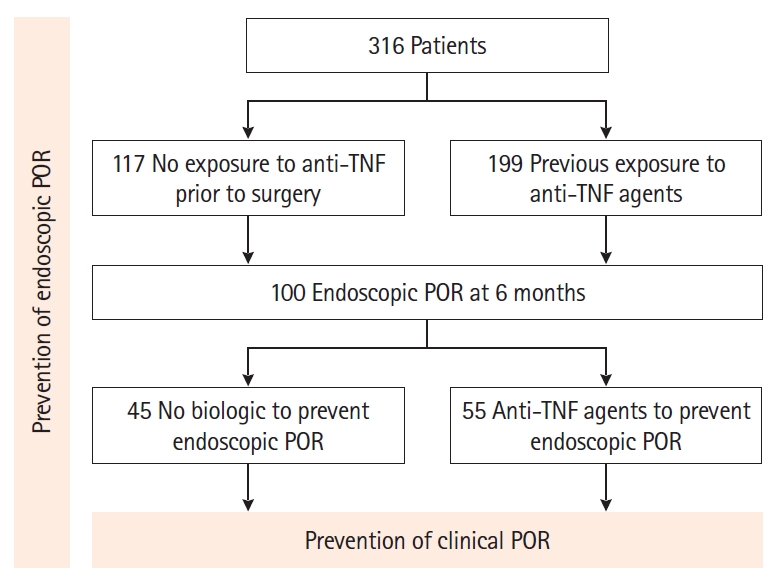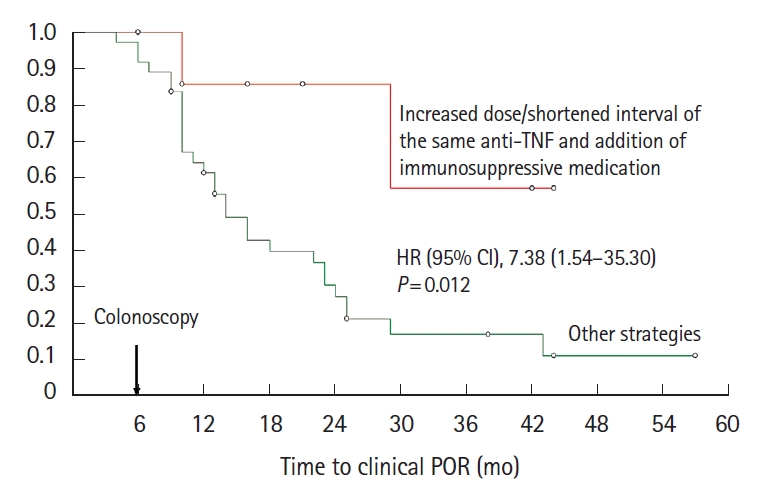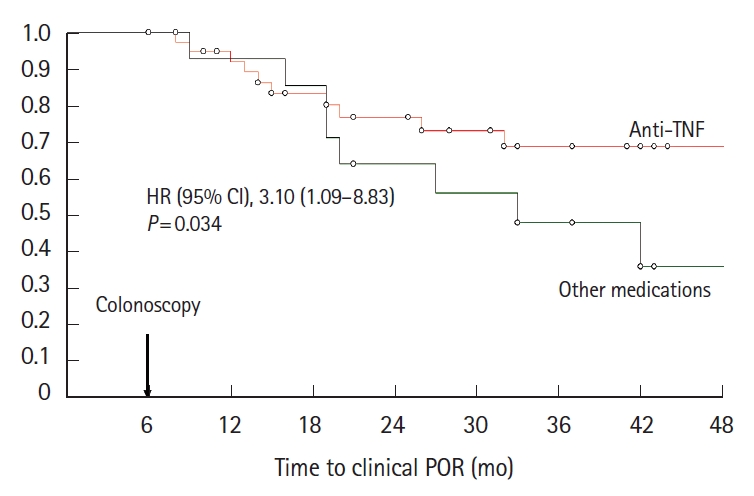1. Pariente B, Mary JY, Danese S, et al. Development of the L├®mann index to assess digestive tract damage in patients with CrohnŌĆÖs disease. Gastroenterology 2015;148:52-63.


3. Peyrin-Biroulet L, Loftus EV Jr, Colombel JF, Sandborn WJ. The natural history of adult CrohnŌĆÖs disease in population-based cohorts. Am J Gastroenterol 2010;105:289-297.


4. Buisson A, Chevaux JB, Allen PB, Bommelaer G, Peyrin-Biroulet L. Review article: the natural history of postoperative CrohnŌĆÖs disease recurrence. Aliment Pharmacol Ther 2012;35:625-633.


5. Rutgeerts P, Geboes K, Vantrappen G, Beyls J, Kerremans R, Hiele M. Predictability of the postoperative course of CrohnŌĆÖs disease. Gastroenterology 1990;99:956-963.


6. Buisson A, Cannon L, Umanskiy K, et al. Natural history of CrohnŌĆÖs disease postoperative recurrence in a US Referral Center in the era of biologics and therapeutic intensification based on early endoscopic findings. Gastroenterology 2018;154:S1-S128.
7. De Cruz P, Kamm MA, Hamilton AL, et al. CrohnŌĆÖs disease management after intestinal resection: a randomised trial. Lancet 2015;385:1406-1417.


8. Buisson A, Chevaux JB, Bommelaer G, Peyrin-Biroulet L. Diagnosis, prevention and treatment of postoperative CrohnŌĆÖs disease recurrence. Dig Liver Dis 2012;44:453-460.


9. Carla-Moreau A, Paul S, Roblin X, Genin C, Peyrin-Biroulet L. Prevention and treatment of postoperative CrohnŌĆÖs disease recurrence with anti-TNF therapy: a meta-analysis of controlled trials. Dig Liver Dis 2015;47:191-196.


10. Gionchetti P, Dignass A, Danese S, et al. 3rd European evidencebased consensus on the diagnosis and management of CrohnŌĆÖs disease 2016: part 2: surgical management and special situations. J Crohns Colitis 2017;11:135-149.


11. Regueiro M, Schraut W, Baidoo L, et al. Infliximab prevents CrohnŌĆÖs disease recurrence after ileal resection. Gastroenterology 2009;136:441-450.


12. Regueiro M, Feagan BG, Zou B, et al. Infliximab reduces endoscopic, but not clinical, recurrence of CrohnŌĆÖs disease after ileocolonic resection. Gastroenterology 2016;150:1568-1578.

13. De Cruz P, Kamm MA, Hamilton AL, et al. Efficacy of thiopurines and adalimumab in preventing CrohnŌĆÖs disease recurrence in high-risk patients: a POCER study analysis. Aliment Pharmacol Ther 2015;42:867-879.


14. Savarino E, Bodini G, Dulbecco P, et al. Adalimumab is more effective than azathioprine and mesalamine at preventing postoperative recurrence of CrohnŌĆÖs disease: a randomized controlled trial. Am J Gastroenterol 2013;108:1731-1742.


16. De Cruz P, Bernardi MP, Kamm MA, et al. Postoperative recurrence of CrohnŌĆÖs disease: impact of endoscopic monitoring and treatment step-up. Colorectal Dis 2013;15:187-197.


17. Colombel JF, Sandborn WJ, Rutgeerts P, et al. Adalimumab for maintenance of clinical response and remission in patients with CrohnŌĆÖs disease: the CHARM trial. Gastroenterology 2007;132:52-65.


19. Burr NE, Hall B, Hamlin PJ, Selinger CP, Ford AC, OŌĆÖConnor A. Systematic review and network meta-analysis of medical therapies to prevent recurrence of post-operative CrohnŌĆÖs disease. J Crohns Colitis 2019;13:693-701.


20. Colombel JF, Sandborn WJ, Reinisch W, et al. Infliximab, azathioprine, or combination therapy for CrohnŌĆÖs disease. N Engl J Med 2010;362:1383-1395.


21. Matsumoto T, Motoya S, Watanabe K, et al. Adalimumab monotherapy and a combination with azathioprine for CrohnŌĆÖs disease: a prospective, randomized trial. J Crohns Colitis 2016;10:1259-1266.


22. Reenaers C, Louis E, Belaiche J, Seidel L, Keshav S, Travis S. Does co-treatment with immunosuppressors improve outcome in patients with CrohnŌĆÖs disease treated with adalimumab? Aliment Pharmacol Ther 2012;36:1040-1048.


23. Kennedy NA, Heap GA, Green HD, et al. Predictors of antiTNF treatment failure in anti-TNF-naive patients with active luminal CrohnŌĆÖs disease: a prospective, multicentre, cohort study. Lancet Gastroenterol Hepatol 2019;4:341-353.

24. Roblin X, V├®rot C, Paul S, et al. Is the pharmacokinetic profile of a first anti-TNF predictive of the clinical outcome and pharmacokinetics of a second anti-TNF? Inflamm Bowel Dis 2018;24:2078-2085.


25. Fay S, Ungar B, Paul S, et al. The association between drug levels and endoscopic recurrence in postoperative patients with CrohnŌĆÖs disease treated with tumor necrosis factor inhibitors. Inflamm Bowel Dis 2017;23:1924-1929.


26. Wright EK, Kamm MA, De Cruz P, et al. Anti-TNF therapeutic drug monitoring in postoperative CrohnŌĆÖs disease. J Crohns Colitis 2018;12:653-661.


27. Gisbert JP, Mar├Łn AC, McNicholl AG, Chaparro M. Systematic review with meta-analysis: the efficacy of a second anti-TNF in patients with inflammatory bowel disease whose previous anti-TNF treatment has failed. Aliment Pharmacol Ther 2015;41:613-623.


28. Yamada A, Komaki Y, Patel N, et al. The use of vedolizumab in preventing postoperative recurrence of CrohnŌĆÖs disease. Inflamm Bowel Dis 2018;24:502-509.


29. Yamamoto T, Umegae S, Matsumoto K. Impact of infliximab therapy after early endoscopic recurrence following ileocolonic resection of CrohnŌĆÖs disease: a prospective pilot study. Inflamm Bowel Dis 2009;15:1460-1466.


















